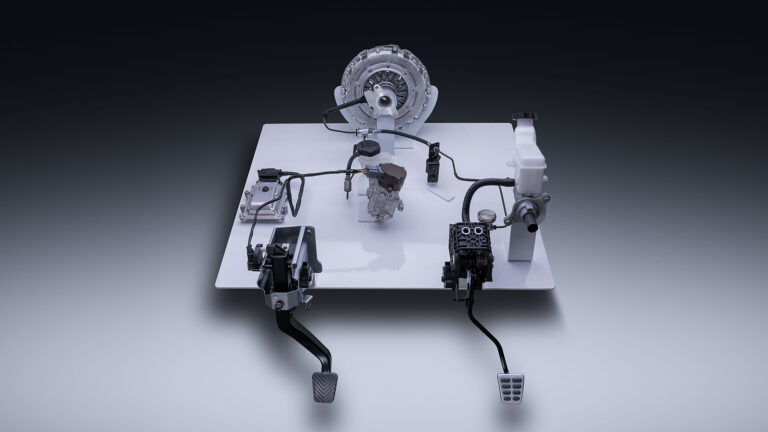With automotive manufacturers needing to ensure their European fleet average CO2 emissions are 95g/km by 2021 (to comply with EC 443/2009), all are hunting for means to reduce these in a cost-effective manner, particularly for C-segment vehicles where margins are tight.
In the case of Kia, the Korean company hopes its newly developed iMT will help it meet these targets. The iMT is effectively a clutch-by-wire system, developed by the Hyundai Motor Europe Technical Center in Offenbach, Germany. “It is still a conventional manual transmission, but the clutch system has been electrified,” explains Dr Michael Winkler, head of powertrain development for Kia in Europe.
The device is intended to complement the company’s 48V mild hybrid systems and will initially be paired with the Ceed’s 1.6-liter CRDi diesel powerplant and the 1.0-liter T-GDi gasoline that sits under the hood of the Rio EcoDynamics+. The layout is simple. Rather than having a master cylinder mechanically linked to the clutch pedal and driving the clutch release bearing, it instead features a pedal position sensor – connected to a TCU – that governs the actuation of an electrohydraulic servo, which in turn operates the clutch release bearing.
“We haven’t done it just for the sake of electrifying the clutch,” comments Winkler. “There were two main drivers. One is customer comfort – many customers like the feel of a manual shift, but there are certain demerits for a manual in terms of comfort. For example, with the electronic system, we can do things like adjust the bite point of the clutch. We can also work on the engine’s stall behavior. However, the key element [behind the system’s development] is that it helps with emissions and fuel savings. We have seen about a 3% reduction under real-world driving conditions.”
The iMT decouples the clutch and shuts off the engine when the driver lifts off the throttle, either to coast or slowing for a corner, aping a stop/start system. “As soon as the accelerator is pressed again, the 48V alternator system is used to provide additional torque and the engine reengages smoothly,” explains Winkler. “The same thing happens when the brake pedal is pressed, utilizing engine braking and providing the feeling that the driver is used to getting with a manual transmission.”
As the system is inoperative when the brakes are applied, the main efficiency savings are found during extra-urban driving, where drivers are on and off the throttle, but not necessarily using the brakes.
Significantly, it’s possible to retrofit the system to the company’s existing manual transmissions, without extensive redesign work. Winkler notes, “The iMT keeps as much of the same componentry as possible [compared with a traditional manual]. We can apply it with minimal modification; all that is changed is the clutch pedal – to one with a sensor – and we add a control unit and an electrohydraulic actuator.”
The main integration challenge for Kia engineers was packaging the system within the Ceed and Rio’s already tight engine bays. “You have to think about things like the placement of the TCU in terms of influences such as temperature levels and so on,” he explains, adding that calibration of the system was as important as the hardware development. “We really had to take care that the calibration properly met the customer demands. It still had to behave like a manual transmission.”
From a customer’s perspective, Winkler says that the pedal feel will be no different to non-iMT-equipped vehicles. “We carried out customer research to find out what they preferred in terms of feel. We could have created whatever feel we wanted, but the feel of a traditional clutch was the direction customers wanted.”
There is, however, a subtle difference in the response rate between the iMT and a mechanical clutch mechanism. “A standard customer, under normal driving, will not notice a difference in the response,” Winkler notes. “With sport driving – of course – any electrohydraulic system has certain characteristics and if it were used in a high-performance application, its limits would appear. But that is not what we are addressing with the Ceed and Rio.”
From a manufacturing perspective, there is an additional cost in integrating the system compared with a manual clutch, but one Kia believes is reasonable. “There is always a trade-off, but we feel that the customer convenience and fuel saving will trade off against the cost increase and we can accept that,” Winkler comments.
For David Labrosse, the company’s head of product planning, the additional cost of adding an iMT system is outweighed by the savings inherent in avoiding penalties for missing required new emissions targets. “From 2021, one gram of CO2 per car will cost us €95 [US$107], so every gram we can save is important,” he emphasizes. “For sure, the cost of this technology is way beyond that, but for us, it is quite clever because it gives choice. You can buy a Kia full electric or a plug-in hybrid, and now with the mild hybrid iMT system, you can have additional tech at a reasonable cost.”


